Aboriginal Community Controlled Health Services (ACCHS): History, Services, and Challenges
VerifiedAdded on 2023/06/13
|6
|1941
|105
AI Summary
This report explains main aim and mission of ACCHS. It consists of brief history, services provided, issues and challenges ACCHS faces while delivering services to people. It also has my personal reflection on my experience with aboriginals who had earlier used the service provided by ACCHS. It is one of the most appropriate community health services for Aboriginal people that provides community-based healthcare.
Contribute Materials
Your contribution can guide someone’s learning journey. Share your
documents today.
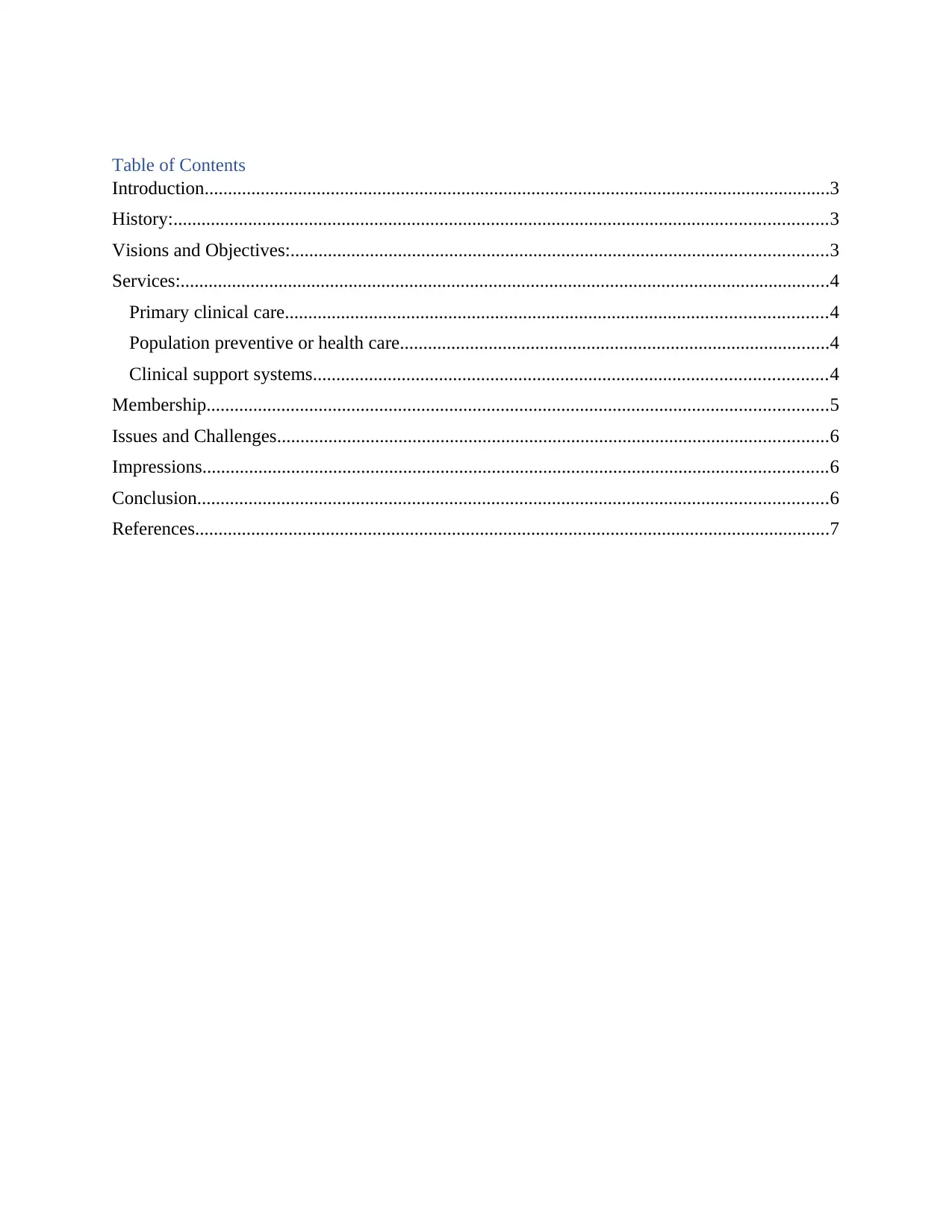
Table of Contents
Introduction......................................................................................................................................3
History:............................................................................................................................................3
Visions and Objectives:...................................................................................................................3
Services:...........................................................................................................................................4
Primary clinical care....................................................................................................................4
Population preventive or health care............................................................................................4
Clinical support systems..............................................................................................................4
Membership.....................................................................................................................................5
Issues and Challenges......................................................................................................................6
Impressions......................................................................................................................................6
Conclusion.......................................................................................................................................6
References........................................................................................................................................7
Introduction......................................................................................................................................3
History:............................................................................................................................................3
Visions and Objectives:...................................................................................................................3
Services:...........................................................................................................................................4
Primary clinical care....................................................................................................................4
Population preventive or health care............................................................................................4
Clinical support systems..............................................................................................................4
Membership.....................................................................................................................................5
Issues and Challenges......................................................................................................................6
Impressions......................................................................................................................................6
Conclusion.......................................................................................................................................6
References........................................................................................................................................7
Secure Best Marks with AI Grader
Need help grading? Try our AI Grader for instant feedback on your assignments.

Introduction:
Indigenous Australians like Aboriginal and Torres Strait Islander people have poor health status
than non-indigenous Australians. They experience high rates of mortality and morbidity
compared to the other Australians due to several factors like lack of education, unemployment,
lack of culturally appropriate health services etc. They are at the highest risk of exposure to
environmental and behavioral risk factors (Freeman, Baum, Lawless, Labonté, & Sanders,
2016). There are many health services and organization for Indigenous People to improve their
current health status.
I first came to know about ACCHS (Aboriginal Control Community Service) when I had visited
the hospital where I met few people who were from Aboriginal community and a member of
ACCHS. While talking to him I got to know about the services and facilities provided by
ACCHS to its member.
History:
In 1971, due to the vulnerable condition of Aboriginal people at Redfern, Aboriginal medical
service (AMS) was established. AMS is now known as ACCHS (Aboriginal Community
Controlled health services and is controlled by the group of aboriginal people. It was basically
originated for aboriginal people of Redfern because they were in urgent need for suitable and
accessible health care services (NACCHO, n.d.). Their primary health care approach was
innovative and focused on the accessibility and need-based health care services.
NACCHO was first established in 1992 as the new national umbrella organization of ACCHS,
by replacing NAIHO. NACCHO stands for National Aboriginal Community Controlled
Organisation. In 1974, a national meeting was held in Albury, Australia to discuss the vulnerable
health of Aboriginal people. NAIHO (National Aboriginal and Islander Health Organization)
was foreshadowed during that meeting. It was then established after a meeting of ACCHS’s in
1976 at Sydney University. ACCHS initially had no specific funding and was mostly dependent
on donations and loans (Alford, 2014). Later, in the mid-1980s it started getting different
government funds and continued to expand, collaborate, increased advocacy capacity, improved
many health policies.
Visions and Objectives:
The vision of ACCHS is to provide primary health care to people from the Aboriginal
community. Its main goal is to deliver comprehensive, holistic and culturally appropriate
treatment or health care service. The main aim of ACCHS is to provide accessibility of health
care service in each part i.e. rural, remote and metropolitan cities of Australia (Weightman,
2013). ACCHS is both run and established by local people of the aboriginal community. The
concept of ACCHS is based on the principle of self-determination and the key role of each
ACCHS is to provide provisions of community support, primary clinical care, advocacy and
special needs programmes (NACCHO, n.d.). The core value of ACCHS is embedded in the
Indigenous Australians like Aboriginal and Torres Strait Islander people have poor health status
than non-indigenous Australians. They experience high rates of mortality and morbidity
compared to the other Australians due to several factors like lack of education, unemployment,
lack of culturally appropriate health services etc. They are at the highest risk of exposure to
environmental and behavioral risk factors (Freeman, Baum, Lawless, Labonté, & Sanders,
2016). There are many health services and organization for Indigenous People to improve their
current health status.
I first came to know about ACCHS (Aboriginal Control Community Service) when I had visited
the hospital where I met few people who were from Aboriginal community and a member of
ACCHS. While talking to him I got to know about the services and facilities provided by
ACCHS to its member.
History:
In 1971, due to the vulnerable condition of Aboriginal people at Redfern, Aboriginal medical
service (AMS) was established. AMS is now known as ACCHS (Aboriginal Community
Controlled health services and is controlled by the group of aboriginal people. It was basically
originated for aboriginal people of Redfern because they were in urgent need for suitable and
accessible health care services (NACCHO, n.d.). Their primary health care approach was
innovative and focused on the accessibility and need-based health care services.
NACCHO was first established in 1992 as the new national umbrella organization of ACCHS,
by replacing NAIHO. NACCHO stands for National Aboriginal Community Controlled
Organisation. In 1974, a national meeting was held in Albury, Australia to discuss the vulnerable
health of Aboriginal people. NAIHO (National Aboriginal and Islander Health Organization)
was foreshadowed during that meeting. It was then established after a meeting of ACCHS’s in
1976 at Sydney University. ACCHS initially had no specific funding and was mostly dependent
on donations and loans (Alford, 2014). Later, in the mid-1980s it started getting different
government funds and continued to expand, collaborate, increased advocacy capacity, improved
many health policies.
Visions and Objectives:
The vision of ACCHS is to provide primary health care to people from the Aboriginal
community. Its main goal is to deliver comprehensive, holistic and culturally appropriate
treatment or health care service. The main aim of ACCHS is to provide accessibility of health
care service in each part i.e. rural, remote and metropolitan cities of Australia (Weightman,
2013). ACCHS is both run and established by local people of the aboriginal community. The
concept of ACCHS is based on the principle of self-determination and the key role of each
ACCHS is to provide provisions of community support, primary clinical care, advocacy and
special needs programmes (NACCHO, n.d.). The core value of ACCHS is embedded in the
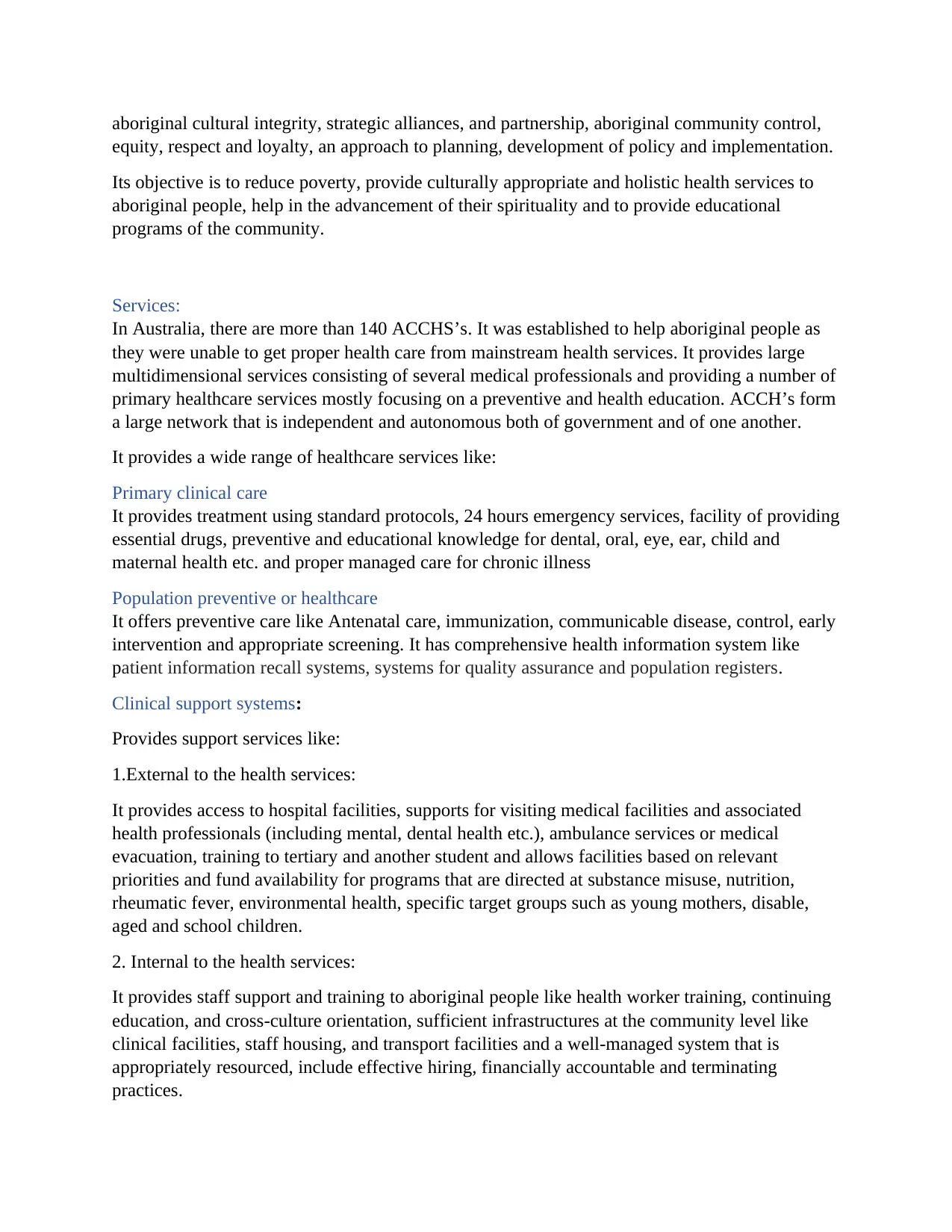
aboriginal cultural integrity, strategic alliances, and partnership, aboriginal community control,
equity, respect and loyalty, an approach to planning, development of policy and implementation.
Its objective is to reduce poverty, provide culturally appropriate and holistic health services to
aboriginal people, help in the advancement of their spirituality and to provide educational
programs of the community.
Services:
In Australia, there are more than 140 ACCHS’s. It was established to help aboriginal people as
they were unable to get proper health care from mainstream health services. It provides large
multidimensional services consisting of several medical professionals and providing a number of
primary healthcare services mostly focusing on a preventive and health education. ACCH’s form
a large network that is independent and autonomous both of government and of one another.
It provides a wide range of healthcare services like:
Primary clinical care
It provides treatment using standard protocols, 24 hours emergency services, facility of providing
essential drugs, preventive and educational knowledge for dental, oral, eye, ear, child and
maternal health etc. and proper managed care for chronic illness
Population preventive or healthcare
It offers preventive care like Antenatal care, immunization, communicable disease, control, early
intervention and appropriate screening. It has comprehensive health information system like
patient information recall systems, systems for quality assurance and population registers.
Clinical support systems:
Provides support services like:
1.External to the health services:
It provides access to hospital facilities, supports for visiting medical facilities and associated
health professionals (including mental, dental health etc.), ambulance services or medical
evacuation, training to tertiary and another student and allows facilities based on relevant
priorities and fund availability for programs that are directed at substance misuse, nutrition,
rheumatic fever, environmental health, specific target groups such as young mothers, disable,
aged and school children.
2. Internal to the health services:
It provides staff support and training to aboriginal people like health worker training, continuing
education, and cross-culture orientation, sufficient infrastructures at the community level like
clinical facilities, staff housing, and transport facilities and a well-managed system that is
appropriately resourced, include effective hiring, financially accountable and terminating
practices.
equity, respect and loyalty, an approach to planning, development of policy and implementation.
Its objective is to reduce poverty, provide culturally appropriate and holistic health services to
aboriginal people, help in the advancement of their spirituality and to provide educational
programs of the community.
Services:
In Australia, there are more than 140 ACCHS’s. It was established to help aboriginal people as
they were unable to get proper health care from mainstream health services. It provides large
multidimensional services consisting of several medical professionals and providing a number of
primary healthcare services mostly focusing on a preventive and health education. ACCH’s form
a large network that is independent and autonomous both of government and of one another.
It provides a wide range of healthcare services like:
Primary clinical care
It provides treatment using standard protocols, 24 hours emergency services, facility of providing
essential drugs, preventive and educational knowledge for dental, oral, eye, ear, child and
maternal health etc. and proper managed care for chronic illness
Population preventive or healthcare
It offers preventive care like Antenatal care, immunization, communicable disease, control, early
intervention and appropriate screening. It has comprehensive health information system like
patient information recall systems, systems for quality assurance and population registers.
Clinical support systems:
Provides support services like:
1.External to the health services:
It provides access to hospital facilities, supports for visiting medical facilities and associated
health professionals (including mental, dental health etc.), ambulance services or medical
evacuation, training to tertiary and another student and allows facilities based on relevant
priorities and fund availability for programs that are directed at substance misuse, nutrition,
rheumatic fever, environmental health, specific target groups such as young mothers, disable,
aged and school children.
2. Internal to the health services:
It provides staff support and training to aboriginal people like health worker training, continuing
education, and cross-culture orientation, sufficient infrastructures at the community level like
clinical facilities, staff housing, and transport facilities and a well-managed system that is
appropriately resourced, include effective hiring, financially accountable and terminating
practices.
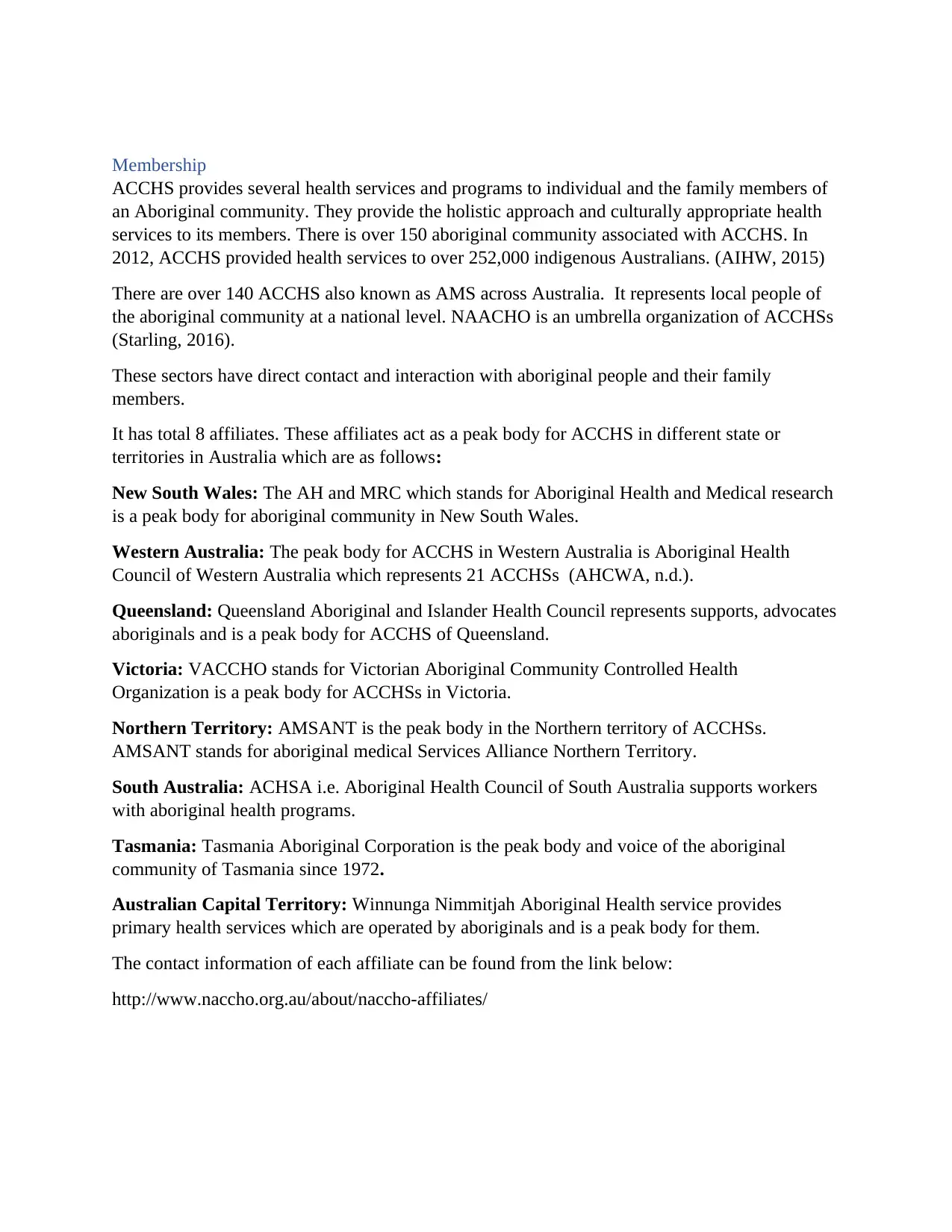
Membership
ACCHS provides several health services and programs to individual and the family members of
an Aboriginal community. They provide the holistic approach and culturally appropriate health
services to its members. There is over 150 aboriginal community associated with ACCHS. In
2012, ACCHS provided health services to over 252,000 indigenous Australians. (AIHW, 2015)
There are over 140 ACCHS also known as AMS across Australia. It represents local people of
the aboriginal community at a national level. NAACHO is an umbrella organization of ACCHSs
(Starling, 2016).
These sectors have direct contact and interaction with aboriginal people and their family
members.
It has total 8 affiliates. These affiliates act as a peak body for ACCHS in different state or
territories in Australia which are as follows:
New South Wales: The AH and MRC which stands for Aboriginal Health and Medical research
is a peak body for aboriginal community in New South Wales.
Western Australia: The peak body for ACCHS in Western Australia is Aboriginal Health
Council of Western Australia which represents 21 ACCHSs (AHCWA, n.d.).
Queensland: Queensland Aboriginal and Islander Health Council represents supports, advocates
aboriginals and is a peak body for ACCHS of Queensland.
Victoria: VACCHO stands for Victorian Aboriginal Community Controlled Health
Organization is a peak body for ACCHSs in Victoria.
Northern Territory: AMSANT is the peak body in the Northern territory of ACCHSs.
AMSANT stands for aboriginal medical Services Alliance Northern Territory.
South Australia: ACHSA i.e. Aboriginal Health Council of South Australia supports workers
with aboriginal health programs.
Tasmania: Tasmania Aboriginal Corporation is the peak body and voice of the aboriginal
community of Tasmania since 1972.
Australian Capital Territory: Winnunga Nimmitjah Aboriginal Health service provides
primary health services which are operated by aboriginals and is a peak body for them.
The contact information of each affiliate can be found from the link below:
http://www.naccho.org.au/about/naccho-affiliates/
ACCHS provides several health services and programs to individual and the family members of
an Aboriginal community. They provide the holistic approach and culturally appropriate health
services to its members. There is over 150 aboriginal community associated with ACCHS. In
2012, ACCHS provided health services to over 252,000 indigenous Australians. (AIHW, 2015)
There are over 140 ACCHS also known as AMS across Australia. It represents local people of
the aboriginal community at a national level. NAACHO is an umbrella organization of ACCHSs
(Starling, 2016).
These sectors have direct contact and interaction with aboriginal people and their family
members.
It has total 8 affiliates. These affiliates act as a peak body for ACCHS in different state or
territories in Australia which are as follows:
New South Wales: The AH and MRC which stands for Aboriginal Health and Medical research
is a peak body for aboriginal community in New South Wales.
Western Australia: The peak body for ACCHS in Western Australia is Aboriginal Health
Council of Western Australia which represents 21 ACCHSs (AHCWA, n.d.).
Queensland: Queensland Aboriginal and Islander Health Council represents supports, advocates
aboriginals and is a peak body for ACCHS of Queensland.
Victoria: VACCHO stands for Victorian Aboriginal Community Controlled Health
Organization is a peak body for ACCHSs in Victoria.
Northern Territory: AMSANT is the peak body in the Northern territory of ACCHSs.
AMSANT stands for aboriginal medical Services Alliance Northern Territory.
South Australia: ACHSA i.e. Aboriginal Health Council of South Australia supports workers
with aboriginal health programs.
Tasmania: Tasmania Aboriginal Corporation is the peak body and voice of the aboriginal
community of Tasmania since 1972.
Australian Capital Territory: Winnunga Nimmitjah Aboriginal Health service provides
primary health services which are operated by aboriginals and is a peak body for them.
The contact information of each affiliate can be found from the link below:
http://www.naccho.org.au/about/naccho-affiliates/
Secure Best Marks with AI Grader
Need help grading? Try our AI Grader for instant feedback on your assignments.
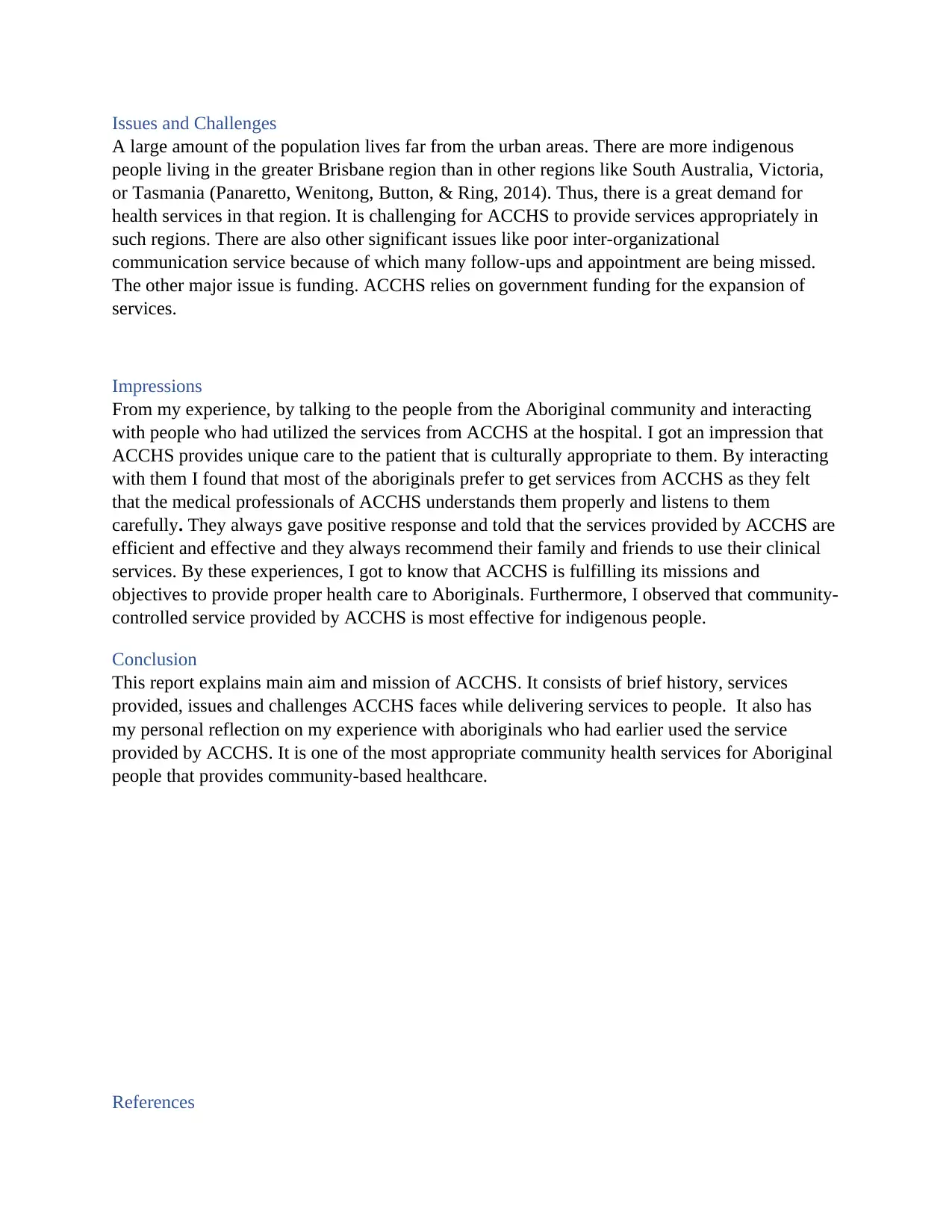
Issues and Challenges
A large amount of the population lives far from the urban areas. There are more indigenous
people living in the greater Brisbane region than in other regions like South Australia, Victoria,
or Tasmania (Panaretto, Wenitong, Button, & Ring, 2014). Thus, there is a great demand for
health services in that region. It is challenging for ACCHS to provide services appropriately in
such regions. There are also other significant issues like poor inter-organizational
communication service because of which many follow-ups and appointment are being missed.
The other major issue is funding. ACCHS relies on government funding for the expansion of
services.
Impressions
From my experience, by talking to the people from the Aboriginal community and interacting
with people who had utilized the services from ACCHS at the hospital. I got an impression that
ACCHS provides unique care to the patient that is culturally appropriate to them. By interacting
with them I found that most of the aboriginals prefer to get services from ACCHS as they felt
that the medical professionals of ACCHS understands them properly and listens to them
carefully. They always gave positive response and told that the services provided by ACCHS are
efficient and effective and they always recommend their family and friends to use their clinical
services. By these experiences, I got to know that ACCHS is fulfilling its missions and
objectives to provide proper health care to Aboriginals. Furthermore, I observed that community-
controlled service provided by ACCHS is most effective for indigenous people.
Conclusion
This report explains main aim and mission of ACCHS. It consists of brief history, services
provided, issues and challenges ACCHS faces while delivering services to people. It also has
my personal reflection on my experience with aboriginals who had earlier used the service
provided by ACCHS. It is one of the most appropriate community health services for Aboriginal
people that provides community-based healthcare.
References
A large amount of the population lives far from the urban areas. There are more indigenous
people living in the greater Brisbane region than in other regions like South Australia, Victoria,
or Tasmania (Panaretto, Wenitong, Button, & Ring, 2014). Thus, there is a great demand for
health services in that region. It is challenging for ACCHS to provide services appropriately in
such regions. There are also other significant issues like poor inter-organizational
communication service because of which many follow-ups and appointment are being missed.
The other major issue is funding. ACCHS relies on government funding for the expansion of
services.
Impressions
From my experience, by talking to the people from the Aboriginal community and interacting
with people who had utilized the services from ACCHS at the hospital. I got an impression that
ACCHS provides unique care to the patient that is culturally appropriate to them. By interacting
with them I found that most of the aboriginals prefer to get services from ACCHS as they felt
that the medical professionals of ACCHS understands them properly and listens to them
carefully. They always gave positive response and told that the services provided by ACCHS are
efficient and effective and they always recommend their family and friends to use their clinical
services. By these experiences, I got to know that ACCHS is fulfilling its missions and
objectives to provide proper health care to Aboriginals. Furthermore, I observed that community-
controlled service provided by ACCHS is most effective for indigenous people.
Conclusion
This report explains main aim and mission of ACCHS. It consists of brief history, services
provided, issues and challenges ACCHS faces while delivering services to people. It also has
my personal reflection on my experience with aboriginals who had earlier used the service
provided by ACCHS. It is one of the most appropriate community health services for Aboriginal
people that provides community-based healthcare.
References
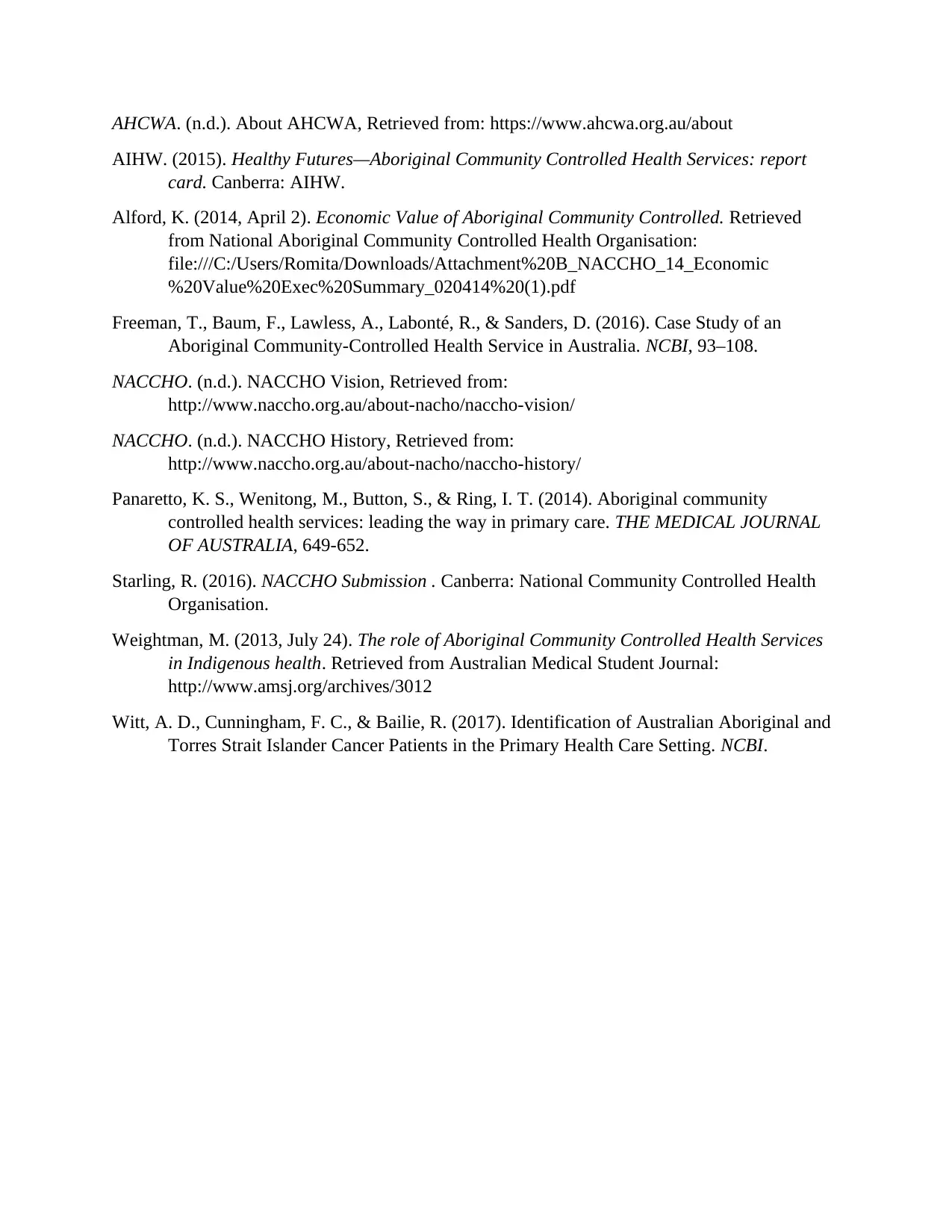
AHCWA. (n.d.). About AHCWA, Retrieved from: https://www.ahcwa.org.au/about
AIHW. (2015). Healthy Futures—Aboriginal Community Controlled Health Services: report
card. Canberra: AIHW.
Alford, K. (2014, April 2). Economic Value of Aboriginal Community Controlled. Retrieved
from National Aboriginal Community Controlled Health Organisation:
file:///C:/Users/Romita/Downloads/Attachment%20B_NACCHO_14_Economic
%20Value%20Exec%20Summary_020414%20(1).pdf
Freeman, T., Baum, F., Lawless, A., Labonté, R., & Sanders, D. (2016). Case Study of an
Aboriginal Community-Controlled Health Service in Australia. NCBI, 93–108.
NACCHO. (n.d.). NACCHO Vision, Retrieved from:
http://www.naccho.org.au/about-nacho/naccho-vision/
NACCHO. (n.d.). NACCHO History, Retrieved from:
http://www.naccho.org.au/about-nacho/naccho-history/
Panaretto, K. S., Wenitong, M., Button, S., & Ring, I. T. (2014). Aboriginal community
controlled health services: leading the way in primary care. THE MEDICAL JOURNAL
OF AUSTRALIA, 649-652.
Starling, R. (2016). NACCHO Submission . Canberra: National Community Controlled Health
Organisation.
Weightman, M. (2013, July 24). The role of Aboriginal Community Controlled Health Services
in Indigenous health. Retrieved from Australian Medical Student Journal:
http://www.amsj.org/archives/3012
Witt, A. D., Cunningham, F. C., & Bailie, R. (2017). Identification of Australian Aboriginal and
Torres Strait Islander Cancer Patients in the Primary Health Care Setting. NCBI.
AIHW. (2015). Healthy Futures—Aboriginal Community Controlled Health Services: report
card. Canberra: AIHW.
Alford, K. (2014, April 2). Economic Value of Aboriginal Community Controlled. Retrieved
from National Aboriginal Community Controlled Health Organisation:
file:///C:/Users/Romita/Downloads/Attachment%20B_NACCHO_14_Economic
%20Value%20Exec%20Summary_020414%20(1).pdf
Freeman, T., Baum, F., Lawless, A., Labonté, R., & Sanders, D. (2016). Case Study of an
Aboriginal Community-Controlled Health Service in Australia. NCBI, 93–108.
NACCHO. (n.d.). NACCHO Vision, Retrieved from:
http://www.naccho.org.au/about-nacho/naccho-vision/
NACCHO. (n.d.). NACCHO History, Retrieved from:
http://www.naccho.org.au/about-nacho/naccho-history/
Panaretto, K. S., Wenitong, M., Button, S., & Ring, I. T. (2014). Aboriginal community
controlled health services: leading the way in primary care. THE MEDICAL JOURNAL
OF AUSTRALIA, 649-652.
Starling, R. (2016). NACCHO Submission . Canberra: National Community Controlled Health
Organisation.
Weightman, M. (2013, July 24). The role of Aboriginal Community Controlled Health Services
in Indigenous health. Retrieved from Australian Medical Student Journal:
http://www.amsj.org/archives/3012
Witt, A. D., Cunningham, F. C., & Bailie, R. (2017). Identification of Australian Aboriginal and
Torres Strait Islander Cancer Patients in the Primary Health Care Setting. NCBI.
1 out of 6
Related Documents
Your All-in-One AI-Powered Toolkit for Academic Success.
+13062052269
info@desklib.com
Available 24*7 on WhatsApp / Email
![[object Object]](/_next/static/media/star-bottom.7253800d.svg)
Unlock your academic potential
© 2024 | Zucol Services PVT LTD | All rights reserved.





